Vibrant feathers typically make birds stand out in trees, but these green bird species tend to use their colors to hide amongst the leaves.
If you are more interested in being able to distinguish one green bird from the next, this article covers some of the most common species of them.
10 Green Bird Species
1. Red-Throated Barbet

- Scientific Name: Psilopogon Mystacophanos
- Size: 8.9 to 9.5 inches
- Weight: 2.1 to 3.4 ounces
- Wingspan: 11.4 inches
As their name suggests, red-throated barbets are distinguishable by a red spot on their throats and also the crown of their heads. However, their bodies are mostly green with a spot of yellow on their crown and blue near their eyes. Females lack the additional colors but are green.
Native to Asia, red-throated barbets are mostly found in Thailand, Malaysia, Brunei, Indonesia, Myanmar, and Singapore and do not migrate. Red-throated barbets make homes in lower humid lands like marshes and swamps.
Both the males and females help build nests and typically put them together in crevices of rocks with the bark from trees. Red-throated barbet broods consist of two to four clutches with one brood born each year.
Red-throated barbets are close to being threatened by extinction with their numbers rapidly declining over the past few years.
2. Glistening-Green Tanager

- Scientific Name: Chlorochrysa Phoenicotis
- Size: 5.1 inches
- Weight: 0.71 to 0.86 ounces
- Wingspan: 9.5 inches
Glistening-green tanagers are covered in bright emerald plumage save from small patches of gray and orange behind their eyes. The main difference between males and females is that males are more vibrant than females.
You can find glistening-green tanagers in the Andean mountain range in Columbia and Ecuador and do not migrate. They prefer tropical or subtropical climates and can be found making homes in the lower forest areas of the mountains.
Monogamous by nature, glistening-green tanagers mate for life and build their nests among the moss that grows on the sides of trees. Glistening-green tanagers have three to five clutches in their one to two broods per year.
Despite their bright coloration, glistening-green tanagers can be difficult to spot amongst leaves and foliage, so they often use their colors to camouflage themselves in their habitats.
3. Green Kingfisher
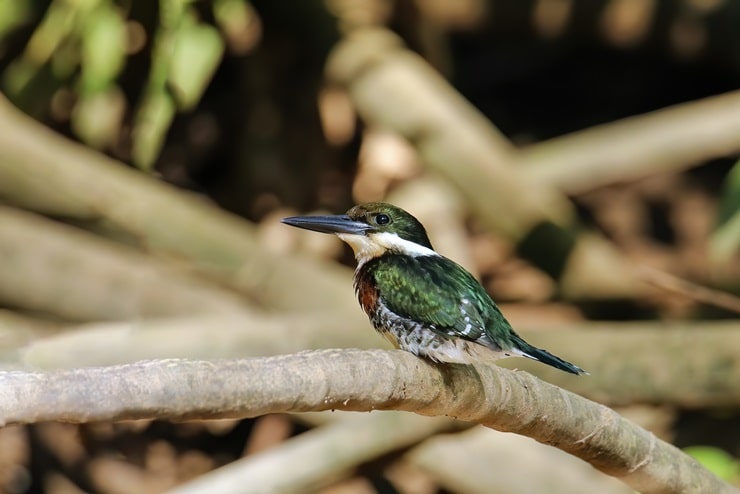
- Scientific Name: Chloroceryle Americana
- Size: 11.8 inches
- Weight: 1.2 to 1.4 ounces
- Wingspan: 11 inches
Easily distinguished by their deep metallic green on their heads and wings, male green kingfishers also have white spots on their wings, reddish-brown chests, and long beaks. Females are the same colors with more rounded heads whereas males have crested ones.
These non-migratory birds are seen throughout most of South America (excluding the western and southern coasts) and Mexico with occasional appearances in the southwestern United States. Green kingfishers prefer to make their homes near vegetation-fill waterways like creeks, streams, rivers, ponds, ditches, and lakes.
Both the male and female protect their nest—a burrow in a dirt bank near water—from others and build them away from nesting pairs. Green kingfishers have one brood per year consisting of three to six clutches.
Their oddly-shaped bills are not made to catch fish or other prey. Green kingfishers use their oblong beaks to hammer into compact areas of soil to make their nests.
4. Violet-Green Swallow
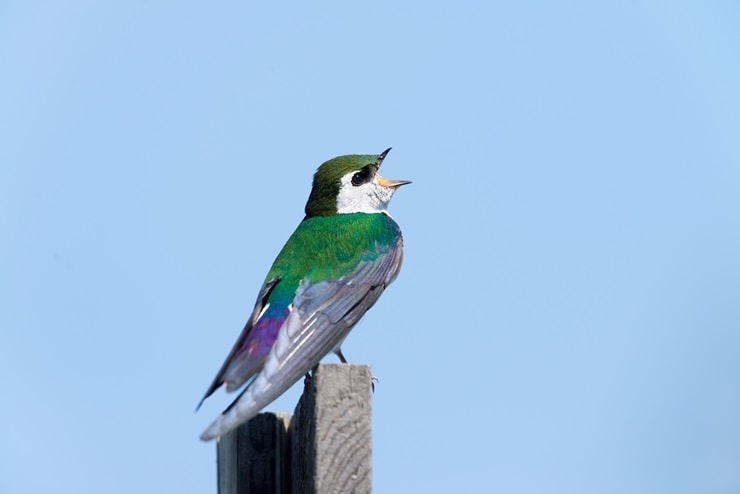
- Scientific Name: Tachycineta Thalassina
- Size: 4.7 inches
- Weight: 0.5 ounces
- Wingspan: 10.6 inches
The overall shape of a violet-green swallow includes long, pointed wings and forked tails that aren’t often seen when perched because their wings are longer. Both the males and females have green heads and back with white chests and violet rumps, but females have dark marks around their eyes.
Violet-green swallows tend to prefer woodlands of either deciduous or evergreen trees, especially those with old and cavity-filled trees. They breed from the northern edge of Mexico and up the western coast to Alaska but stay in central Mexico all year.
The old cavities in trees come in hand when pairs or small colonies start to nest, and, if those cannot be found, violet-green swallows will opt for holes or crevices in rocks. They have one, occasionally two, brood per year with four to six clutches.
Though peregrine falcons are known for being the fastest bird at around 25 to 35 miles per hour, violet-green swallows have been seen flying around 28 miles per hour.
5. Great Green Macaw

- Scientific Name: Ara Ambiguus
- Size: 33.5 to 35.5 inches
- Weight: 2.8 to 3 pounds
- Wingspan: 44 to 50 inches
As the name implies, great green macaws are covered from head to tail in green feathers with signature blue markings on their backs, rumps, tips of their tails, and upper tail feathers. They also have a distinctive red band across the top of their large, hooked beak.
Great green macaws are known to frequent Central America and northern South America but have also been introduced as far east as Singapore. Living in groups of five to six, great green macaws tend to make homes in the holes of trees, with a particular love for Almendro trees that grow in humid lowlands.
Nesting in the large cavities in trees, female great green macaws will build nests while males gather the materials. When the time comes a female has a minimum of one brood per year consisting of two to three eggs.
Great green macaws are on the endangered list due to capturing and selling them as pets. This occurred so frequently that there are an estimated 2,500 left in the wild with only 30 to 40 still living in Ecuador.
6. Green Jay
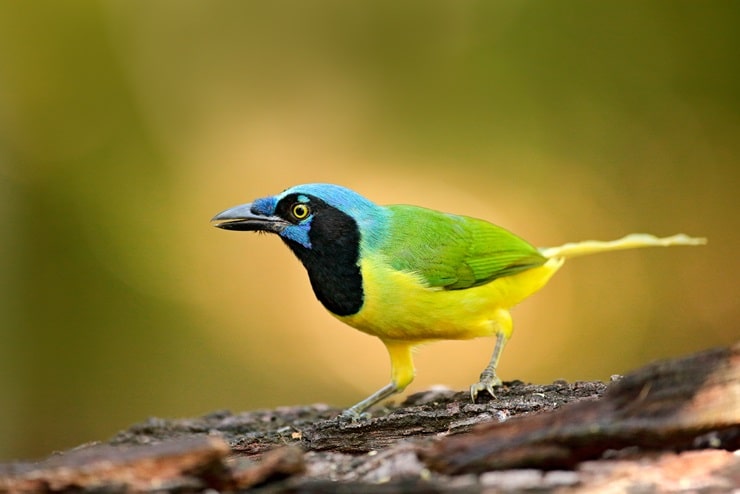
- Scientific Name: Cyanocorax Yncas
- Size: 9.8 to 11 inches
- Weight: 2.3 to 3.9 ounces
- Wingspan: 15 inches
Similar in size and shape to the blue jay, green jays are slender with long tail feathers and rounded heads. Males tend to be green-bodied with blue heads with black markings on their face and neck while females have yellow on the underside of their tail feathers.
Liking tropical climates, green jays can be found in the northern part of the Andes and on the eastern coast of Mexico while occasionally being seen in the southern tip of Texas. These birds prefer native trees that can be found in woodlands and thickets but will settle for introduced trees like those in parks.
Both males and females help build the nest in trees or shrubs. A female will have three to five eggs and in the north, they will only have one brood but some in the south have had two broods.
Like blue jays, green jays are excellent mimics and have been known to replicate the sound of hawks to scare away other species.
7. Green-Breasted Mango

- Scientific Name: Anthracothorax Prevostii
- Size: 4.3 to 4.7 inches
- Weight: 0.23 to 0.25 ounces
- Wingspan: 6.25 inches
The green-breasted mango is a large hummingbird with unmistakable color. Males have glossy bright green bodies with blue-green feathers on their edges while females are glossy brown-green with white underparts and teal under their black throats.
Seen from southern Mexico to Central America and the northern tip of South America, these partially migratory like to make homes in deciduous woodlands and savannahs.
Green-breasted mangos nest in brushes, shrubs, or trees, and the female will build the nest by herself, trying to camouflage it with moss. She will have up to two broods per year with typically two clutches per brood.
Unlike most birds, green-breasted mangos are fiercely independent and do not travel with a group or bond in pairs.
8. Green Parakeet

- Scientific Name: Psittacara Holochlorus
- Size: 12.6 inches
- Weight: 15 to 35 pounds
- Wingspan: 13.5 to 14.5 inches
As the name would suggest, green parakeets are primarily green from head to tail with a lighter green chest than their heads and wings and a yellow hooked beak. Females are usually significantly smaller than males.
Green parakeets are native to Mexico and Central America but have expanded to southern Texas and a few other warm-climate southern states like Florida. In the United States, green parakeets make do with palm groves but prefer to make homes in swampy forests, humid woodlands, and forest clearings.
Like many other birds, green parakeets make nests in old woodpecker holes or other cavities in trees. Females will have one to two broods per year—occasionally three in southern areas— with four to eight eggs per brood.
Green parakeets are able to become pets and many people have them in their homes due to their high intelligence and bonding ability.
9. Rivoli’s Hummingbird
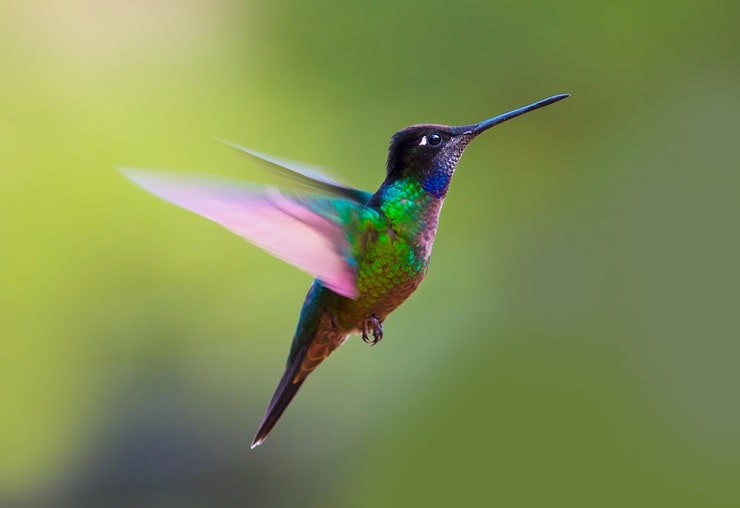
- Scientific Name: Eugenes Fulgens
- Size: 4.3 to 5.5 inches
- Weight: 0.21 to 0.35 ounces
- Wingspan: 7.1 inches
Though they may seem all black in dark lighting, male Rivoli’s hummingbirds are mostly dark green with purple on their crowns, green-yellow throats, and a white patch behind their eyes. Females can be distinguished by their significantly lighter underbellies.
Rivoli’s hummingbird can be found mostly in central Mexico while migrating to northern Mexico and the southern United States in the warmer months. They prefer to make homes cooler canyons located in mountain ranges near streams and creeks.
Females will make their cup-shaped nests and cover them in moss to help disguise them from predators. Rivoli’s hummingbirds mate all year round and have two eggs per brood.
Just like other hummingbirds, Rivoli’s hummingbirds have one of the quickest heart rates ever recorded at between 420 to 1,200 beats per minute!
10. Kentucky Warbler
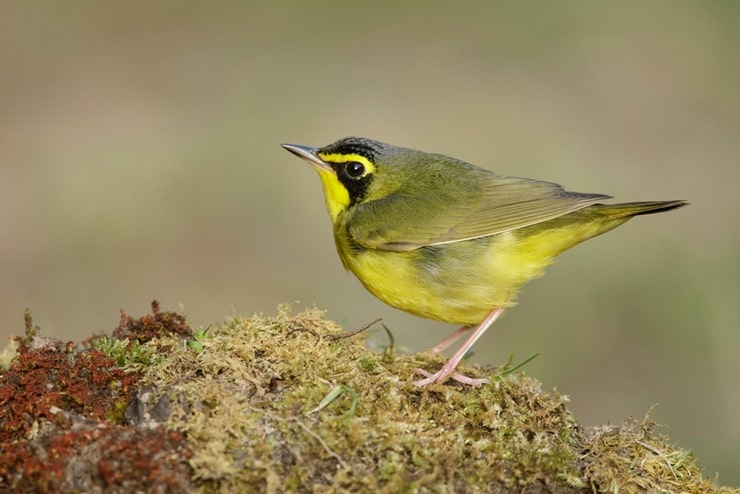
- Scientific Name: Geothlypis Formosa
- Size: 5.1 inches
- Weight: 0.5 ounces
- Wingspan: 7.9 to 8.7 inches
This sturdy little long-legged bird is distinguishable by their completely yellow underbellies with olive green tops and black markings on their faces. Female Kentucky warblers often appear more gray than black with smaller, mottled caps.
Despite the name, Kentucky warblers spend most of the year in Mexico, Central America, and northern South America while only venturing into the southeastern/eastern United States to breed in warmer months. They prefer woodlands with damp underbrushes that are near streams or creeks.
Kentucky warblers will nest on the ground or no more than a foot up in ground shrubbery. Females typically have two broods per year with three to six eggs in each brood.
Most songbirds have a few different songs they can sing, but male Kentucky warblers only have one song type that he sings throughout their lives.
Other Colorful Birds:
Red Birds
Brown Birds
Purple Birds
